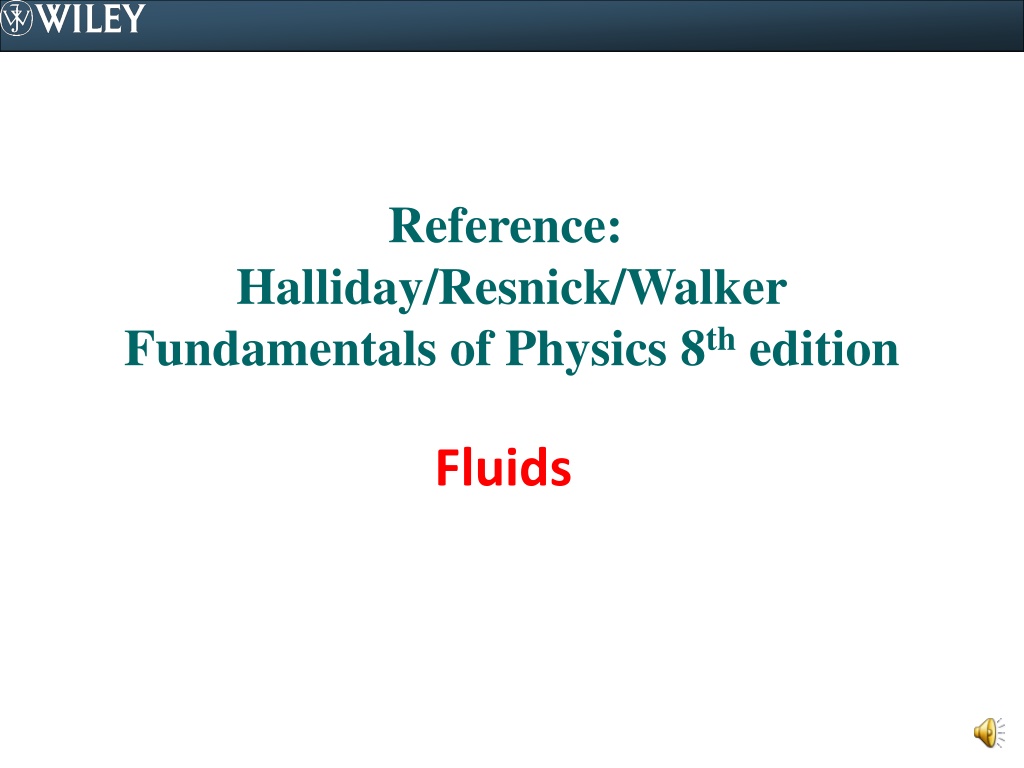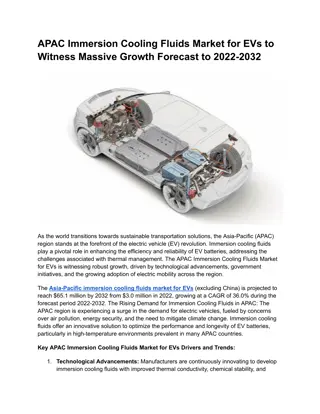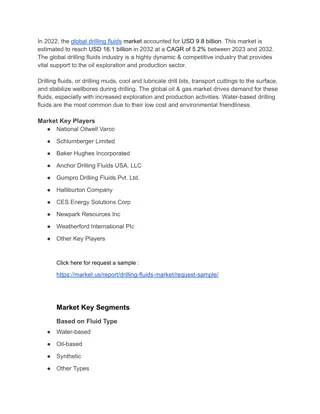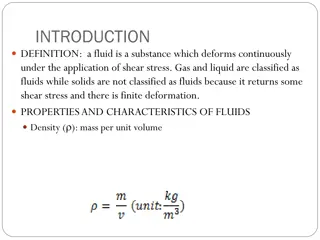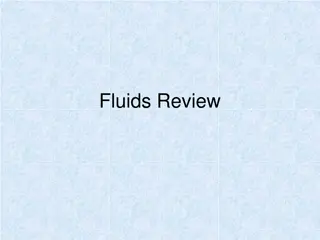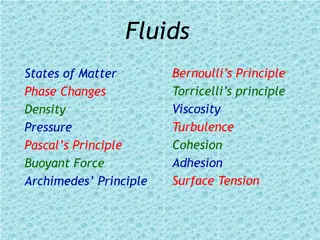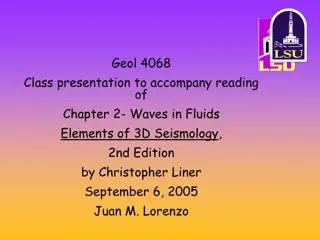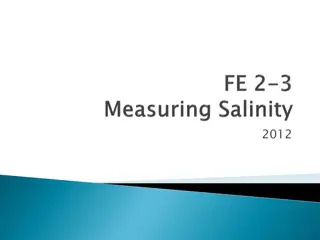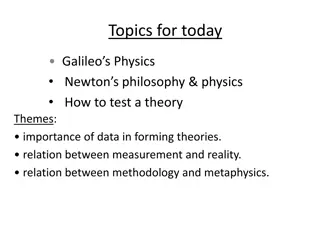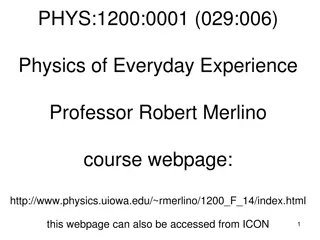Understanding Fluids in Physics
Fluids play a crucial role in physics, encompassing both liquids and gases. Learn about the properties of fluids, such as density and pressure, through practical examples and questions from renowned physics textbooks.
Download Presentation

Please find below an Image/Link to download the presentation.
The content on the website is provided AS IS for your information and personal use only. It may not be sold, licensed, or shared on other websites without obtaining consent from the author. Download presentation by click this link. If you encounter any issues during the download, it is possible that the publisher has removed the file from their server.
E N D
Presentation Transcript
Reference: Halliday/Resnick/Walker Fundamentals of Physics 8th edition Fluids
1. Which one of the following statements best describes fluids? a) Fluids are liquids. b) Fluids are gases. c) Fluids are transparent. d) Fluids are gases or liquids. e) Fluids are opaque.
2. Which one of the following substances is not a fluid? a) mercury b) air c) water d) liquid nitrogen e) all of the above are fluids
3. The density of mercury is 1.36 104 kg/m3. What is the mass of a 4.00 10 4-m3 sample of mercury? a) 6.29 kg b) 5.44 kg c) 2.94 kg d) 0.0343 kg e) 0.002 94 kg
4. A cube of a certain metal has 0.040-m sides and its mass is 0.48 kg. What is the mass density of the cube? a) 12 kg/m3 b) 300 kg/m3 c) 1800 kg/m3 d) 7500 kg/m3 e) 8700 kg/m3
5. Which of the following choices is equivalent to the SI unit of pressure, the pascal? a) N/m b) N/m s2 c) kg/m s2 d) N/s e) kg m/s2
6. Complete the following statement: Pressure is a measure of a) the force exerted by a fluid. b) the force per unit area that a fluid exerts. c) the force per unit time that a fluid exerts. d) the impulse of a fluid. e) the energy in a fluid.
7. Which one of the following is equal to the pressure of the earths atmospheric pressure at sea level? a) 1.60 104Pa b) 1.01 105Pa c) 1.09 106Pa d) 1.31 107Pa e) 2.70 107 Pa
8. In which one of the following cases is the pressure exerted on the ground by the man the largest? a) A man stands with both feet flat on the ground. b) A man stands with one foot flat on the ground. c) A man lies with his back flat on the ground. d) A man kneels with both knees on the ground. e) A man stands with the toes of one foot on the ground.
9. Which one of the following expressions gives the correct relationship between pressure and force? a) P = F/A b) P = FA c) P = F d) P = A/F e) There is no relationship between pressure and force.
10. The pressure at a point in a fluid in static equilibrium depends on which of the following? a) the total depth of the fluid b) the depth of the given point c) the total volume of fluid d) both choices a) and b) e) both choices a) and c)
11. Which one of the following statements best describes the pressure in a static, homogeneous liquid? a) The pressure is the same at all points in the fluid. b) The pressure is not dependent on the atmospheric pressure exerted at the surface of the liquid. c) At a given depth in the liquid, the pressure is the same at all points at that depth. d) The pressure depends on the type of liquid. The denser the liquid is, the smaller the pressure will be. e) The pressure decreases as the depth increases.
12. Which one of the following statements best explains why the pressure in a static fluid increases as the depth increases? a) The density of the fluid increases with depth. b) As the depth increases, the weight of the water above a particular level increases. c) As the depth increases, the density of the fluid decreases. d) As depth increases, the gravitational force of the earth on the water increases. e) The temperature of the water decreases with depth.
13. Consider the drawing of the liquid within the U-shaped tube that has both sides open at the top. Is this fluid in equilibrium? a) Yes, the fluid must be in equilibrium. b) No, side A should be lower than side B. c) No, side B should be lower than side A d) No, both sides should be at the same height. e) The answer may be yes or no, depending on the density of the fluid.
14. Consider the drawing of the liquid within the U-shaped tube that has one side sealed. Is this fluid in equilibrium? a) Yes, the fluid can be in equilibrium. b) No, side A should be lower than side B. c) No, side B should be lower than side A d) No, both sides should be at the same height. e) The answer may be yes or no, depending on the density of the fluid.
15. Which of the following devices is used to measure atmospheric pressure? a) manometer b) barometer c) goniometer d) pascalometer e) dynamometer
16. Which of the following devices is used to measure gauge pressure? a) manometer b) barometer c) goniometer d) pascalometer e) dynamometer
17. Complete the following sentence: The operation of a hydraulic jack is an application of a) Archimedes principle. b) Bernoulli's principle. c) Pascal's principle. d) the continuity equation. e) irrotational flow.
18. A U-shaped tube is connected to a flexible tube that has a membrane- covered funnel on the opposite end as shown in the drawing. Jason finds that no matter which way he orients to membrane, the height of the liquid in the U-shaped tube does not change. Which one of the following choices best describes this behavior? a) Archimedes principle b) Bernoulli's principle c) irrotational flow d) the continuity equation e) Pascal's principle
19. Which one of the following statements concerning a completely enclosed fluid is true? a) Any change in applied pressure produces an equal change in pressure at all points within the fluid. b) An increase in pressure in one part of the fluid results in an equal decrease in pressure in another part. c) The pressure at all points within the fluid is independent of any pressure applied to it. d) Any change in the applied pressure of the fluid produces a change in pressure that depends on direction. e) The pressure in the fluid is the same at all points within the fluid.
20. While using a hydraulic lever, a force F is applied over a distance d. Which of the following is a likely result of this applied force? a) a larger force is attained over the same distance d b) a larger force is attained over a distance greater than d c) a larger force is attained over a distance smaller than d d) a same force F is attained over a distance smaller than d e) a smaller force than F is attained over a distance smaller than d
21. Which one of the following statements concerning the buoyant force on an object submerged in a liquid is true? a) The buoyant force will increase with depth if the liquid is incompressible. b) The buoyant force depends on the volume of the liquid displaced. c) The buoyant force depends on the weight of the object. d) The buoyant force depends on the mass of the object. e) The buoyant force is independent of the density of the liquid.
22. Under what circumstances will an object that is solid throughout float on water? a) A totally solid object can never float on water because it needs to have air in it. b) If the shape of the object is like that of a boat, it will float. c) A totally solid object can float on water if its volume is greater than the volume of water it displaces. d) A totally solid object can float on water if its density is less than the density of water. e) A totally solid object can float on water if its density is greater than the density of water.
23. Complete the following statement: When an object is placed in a fluid, a buoyant force is exerted on it that is directed upward with a magnitude a) that is greater than the force of gravity on the object. b) that is greater than the weight of the fluid displaced by the object. c) that is equal to the weight of the fluid displaced by the object. d) that is less than the weight of the fluid displaced by the object. e) that is equal to the force of gravity on the object.
24. Which one of the following statements does not describe a property of fluids in motion? a) The fluid flow can be steady or unsteady. b) The fluid flow can be compressible or incompressible. c) The fluid flow can be steadfast or unreliable. d) The fluid flow can be viscous or nonviscous. e) The fluid flow can be turbulent or streamline.
25. Which one of the following statements best describes laminar flow in fluids. a) At a given point in the moving fluid, the fluid velocity is constant. b) At all points in the moving fluid, the fluid velocity is constant. c) Fluid particles only move along streamlines within the fluid. Particles not on a streamline do not move. d) All particles within the fluid follow straight lines called streamlines and their velocity is constant. e) At a given point on a streamline, the fluid velocity is varying, but the average velocity along the streamline is constant.
26. Which one of the following statements concerning steady flow is true? a) Steady flow is described by Pascal's principle. b) Steady flow is described by Archimedes principle. c) The velocity vectors are the same for all particles in the fluid. d) At any given point in the fluid, the velocity is constant in time. e) Steady flow occurs when there are sharp obstacles in the path of a fast-moving fluid.
27. Which one of the following statements concerning an ideal fluid is false? a) When an ideal fluid flows, the flow is non-laminar. b) When an ideal fluid flows, the fluid does not experience viscous drag. c) An ideal fluid is incompressible. d) When an ideal fluid flows at a steady rate, the velocity at a given point does not change with time. e) An ideal fluid undergoes irrotational flow.
28. Which law, principle, or equation specifies that the mass flow rate of a fluid at two positions along a tube must be constant? a) Archimedes' principle b) Pascal's principle c) Poiseuille's law d) equation of continuity e) Bernoulli's equation
29. Oil is flowing through a tube that has two different cross-sectional areas as shown in the drawing. At position A where the radius of the tube is 7.0 cm, the mass flow rate of the oil is 0.025 kg/s. What is the mass flow rate at position B where the radius of the tube is 3.5 cm? a) 0.013 kg/s b) 0.025 kg/s c) 0.038 kg/s d) 0.050 kg/s e) 0.10 kg/s
30. Complete the following statement: Bernoulli's principle is a statement of a) momentum conservation in dynamic fluids. b) energy conservation in dynamic fluids. c) mechanical equilibrium in fluids. d) thermal equilibrium in fluids. e) hydrostatic equilibrium.
31. Which one of the following statements is false concerning the derivation or usage of Bernoulli s equation? a) Streamline flow is assumed. b) The fluid must be incompressible. c) The fluid must be non-viscous. d) The work-energy theorem is used to derive Bernoulli s equation. e) Vertical distances are always measured relative to the lowest point within the fluid.
